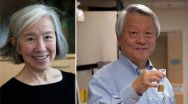(Press-News.org) Ground-breaking research by a UCLA team of physicians and engineers demonstrates that prostate cancer can be diagnosed using image-guided targeted biopsy.
Traditionally found only by blind biopsy, a procedure that dates from the 1980s, prostate cancer now appears detectable by direct sampling of tumor spots found using Magnetic Resonance Imaging (MRI) in combination with real-time ultrasound, according to the UCLA study released Dec. 10, 2012 early online for the January 2013 issue of The Journal of Urology®.
The study indicates that the MRI and ultrasound fusion biopsy, which is much more accurate than conventional blind biopsy, may lead to a reduction in the numbers of prostate biopsies performed and allow for early detection of serious prostate cancers.
The study involved 171 men who were using active surveillance to monitor slow growing prostate cancers or men who had persistently elevated prostate specific antigen (PSA) --a protein produced by the prostate that can indicate the presence of cancer – but had prior negative biopsies. The UCLA biopsies were done in about 20 minutes in an outpatient clinic setting under local anesthesia.
Elevations in serum PSA level trigger nearly all of the one million prostate biopsies performed in the United States every year. Annually, about 240,000 new cases of prostate cancer are discovered. Thus, about 75 percent of the biopsies are negative for cancer. However many of those men with negative biopsies but elevated PSA levels may still harbor malignant tumors that were missed by conventional biopsies, said study senior author Dr. Leonard S. Marks, a professor of urology and director of the UCLA Active Surveillance Program.
"Early prostate cancer is difficult to image because of the limited contrast between normal and malignant tissues within the prostate," Marks said. "Conventional biopsies are basically performed blindly, because we can't see what we're aiming for. Now, with this new method that fuses MRI and ultrasound, we have the potential to see the prostate cancer and aim for it in a much more refined and rational manner."
The new targeting process is the result of four years of work funded by the National Cancer Institute and based in the Clark Urology Center at UCLA.
Since the mid-1980s, prostate cancer has been diagnosed using trans-rectal ultrasound to sample the prostate. Unlike most other cancers, prostate cancer is the only major malignancy diagnosed without actually visualizing the tumor as a biopsy is done, Marks said.
With the advent of sophisticated MRI, imaging the prostate improved and provided a picture of tumors within the organ. However, trying to biopsy the prostate with the patient inside the MRI has proved to be cumbersome, expensive and time consuming. Thus the fusion process evolved, permitting the targeted biopsy to be done in a clinic setting.
In this study, the volunteers undergo MRI first to visualize the prostate and any lesions. That information is then fed into a device called the Artemis, which fuses the MRI pictures with real-time, three-dimensional ultrasound, allowing the urologist to see the lesion during the biopsy.
"With the Artemis, we have a virtual map of the suspicious areas placed directly onto the ultrasound image during the biopsy," Marks said. "When you can see a lesion, you've got a major advantage of knowing what's really going on in the prostate. The results have been very dramatic, and the rate of cancer detection in these targeted biopsies is very high. We're finding a lot of tumors that hadn't been found before using conventional biopsies."
Prostate cancer was found in 53 percent of 171 study volunteers. Of those tumors found by the fusion biopsy technique, 38 percent had a Gleason score of greater than seven, which indicates an aggressive tumor, more likely to spread than tumors with lower scores. Once prostate cancer spreads, it's much more difficult to treat and survival decreases.
Robert Meier, a 58-year-old high school art teacher from Visalia, enrolled in Marks' study after three prostate biopsies all came back negative for cancer despite climbing PSA levels.
In 2008, Meier tore his rotator cuff and as part of his pre-surgery exam, blood tests were done. His PSA was at six – four or lower is considered normal. His doctor sent him to an urologist, who performed tests to rule out everything else that could be causing high PSA levels, including infection and an enlarged prostate. The doctor found nothing. Meanwhile Meier's PSA climbed to eight.
A biopsy was performed and was negative. Meier's PSA jumped to nine and yet another biopsy came back negative. When his PSA reached 11.7, another round of biopsies was ordered.
"These biopsies can be extremely painful and I was put in the hospital several times so they could be done under general anesthesia," Meier said. "It takes about a month to recover."
And like his PSA levels, Meier's anxiety was also rising. If he didn't have prostate cancer, why were his levels going up?
After a second opinion in Santa Barbara and months of being tested and treated with a medicine designed to shrink his prostate and lower PSA, Meier was referred to UCLA and Marks in 2011. By then his PSA was nearly 18, up more than 10 points in three years. An MRI revealed a prostate lesion and he underwent a biopsy using the Artemis device. He did have cancer, and it was aggressive.
"Dr. Marks told me that I had a cancer that could spread and it needed to come out now," Meier said. "He told me that at my relatively young age and the severity of the tumor, I had no choice."
Meier's prostate and 24 nearby lymph nodes were removed robotically at UCLA in February by Dr. Arnold Chin, assistant professor of urology. Follow up tests show that Meier is cancer free today.
"This program works," Meier said. "I had jumped through all these hoops and had all these tests with two different doctors and they found nothing. It took UCLA to determine that I had an aggressive cancer that could have killed me. I feel like I was in very good hands at UCLA."
The UCLA study team included doctor-scientists from urology, radiology, pathology, the Center for Advanced Surgical and Interventional Technology (CASIT) and biomedical engineering.
"Prostate lesions identified on MRI can be accurately targeted with MR-Ultrasound fusion biopsy in a clinic setting using local anesthesia," the study states. "Biopsy findings correlate with the level of suspicion on MRI. Targeted prostate biopsy has the potential to improve the diagnosis of prostate cancer and may aid in the selection of patients for active surveillance and focal therapy."
###
The study was supported by the National Cancer Institute (RO1CA158627). The MRI and ultrasound fusion technology used in the study is described in a video posted here.
http://www.youtube.com/watch?v=IcLwL2dcK5o END
Prostate cancer now detectable by imaging-guided biopsy
Findings may end 25-year era of blind biopsy
2012-12-10
ELSE PRESS RELEASES FROM THIS DATE:
Targeted prostate biopsy has potential to improve diagnosis of prostate cancer
2012-12-10
New York, NY, December 10, 2012 – Diagnosis of prostate cancer remains imperfect. Current methods of prostate biopsy are limited by over detection of slow-growing tumors and under detection of clinically relevant cancers. Investigators at the University of California-Los Angeles Department of Urology have found that a new technique of targeted biopsy in a clinic setting, using local anesthesia, may improve diagnosis and aid in selecting which patients are suitable for active surveillance and which need focal therapy (noninvasive techniques for destroying small tumors within ...
Renewables and storage could power grid 99.9 percent of the time
2012-12-10
Renewable energy could fully power a large electric grid 99.9 percent of the time by 2030 at costs comparable to today's electricity expenses, according to new research by the University of Delaware and Delaware Technical Community College.
A well-designed combination of wind power, solar power and storage in batteries and fuel cells would nearly always exceed electricity demands while keeping costs low, the scientists found.
"These results break the conventional wisdom that renewable energy is too unreliable and expensive," said co-author Willett Kempton, professor ...
Secrets of gentle touch revealed
2012-12-10
Stroke the soft body of a newborn fruit fly larva ever-so-gently with a freshly plucked eyelash, and it will respond to the tickle by altering its movement—an observation that has helped scientists at the University of California, San Francisco (UCSF) uncover the molecular basis of gentle touch, one of the most fundamental but least well understood of our senses.
Our ability to sense gentle touch is known to develop early and to remain ever-present in our lives, from the first loving caresses our mothers lavish on us as newborns to the fading tingle we feel as our lives ...
Temple scientists target DNA repair to eradicate leukemia stem cells
2012-12-10
(Philadelphia, PA) – Despite treatment with imatinib, a successful drug that targets chronic myeloid leukemia (CML), a deadly type of cancer, some patients may continue to be at risk for relapse because a tiny pool of stem cells is resistant to treatment and may even accumulate additional genetic aberrations, eventually leading to disease progression and relapse. These leukemia stem cells are full of genetic errors, loaded with potentially lethal breaks in DNA, and are in a state of constant self-repair.
Now, scientists at Temple University School of Medicine may have ...
Bugs without borders
2012-12-10
Researchers show that the global epidemic of Clostridium difficile 027/NAP1/BI in the early to mid-2000s was caused by the spread of two different but highly related strains of the bacterium rather than one as was previously thought. The spread and persistence of both epidemics were driven by the acquisition of resistance to a frontline antibiotic.
Unlike many other healthcare-associated bacteria, C. difficile produces highly resistant and infectious spores. These spores can promote the transmission of C. difficile and potentially facilitates its spread over greater geographical ...
What it is to be a queen bee?
2012-12-10
Queen sweat bees 'choose' the role of their daughters, according to a new study published in BioMed Central's open access journal Frontiers in Zoology. The amount of food provided for the developing larvae determines whether the daughter becomes a worker or a new queen.
The sweat bee Halictus scabiosae are a primitive eusocial insect. Eusocial insects have a hierarchical society with a division of labor between reproductive queens and males, and workers. However for H. scabiosae all the adults have retained the ability to reproduce, although their role in the nest may ...
Brain study shows why some people are more in tune with what they want
2012-12-10
Wellcome Trust researchers have discovered how the brain assesses confidence in its decisions. The findings explain why some people have better insight into their choices than others.
Throughout life, we're constantly evaluating our options and making decisions based on the information we have available. How confident we are in those decisions has clear consequences. For example, investment bankers have to be confident that they're making the right choice when deciding where to put their clients' money.
Researchers at the Wellcome Trust Centre for Neuroimaging at UCL ...
Engineered immune cells produce complete response in child with an aggressive pediatric leukemia
2012-12-10
By reprogramming a 7-year-old girl's own immune cells to attack an aggressive form of childhood leukemia, a pediatric oncologist has achieved a complete response in his patient, who faced grim prospects when she relapsed after conventional treatment. The innovative experimental therapy used bioengineered T cells, custom-designed to multiply rapidly in the patient, and then destroy leukemia cells. After the treatment, the child's doctors found that she had no evidence of cancer.
Pediatric oncologist Stephan A. Grupp, M.D., Ph.D., of The Children's Hospital of Philadelphia, ...
Leukemia patients remain in remission more than 2 years after engineered T cell therapy
2012-12-10
ATLANTA -- Nine of twelve leukemia patients who received infusions of their own T cells after the cells had been genetically engineered to attack the patients' tumors responded to the therapy, which was pioneered by scientists in the Perelman School of Medicine at the University of Pennsylvania. Penn Medicine researchers will present the latest results of the trial today at the American Society of Hematology's Annual Meeting and Exposition.
The clinical trial participants, all of whom had advanced cancers, included 10 adult patients with chronic lymphocytic leukemia treated ...
Reduced intensity regimen prior to marrow transplant better for older leukemia patients
2012-12-10
COLUMBUS, Ohio – A new study led by researchers at the Ohio State University Comprehensive Cancer Center – Arthur G. James Cancer Hospital and Richard J. Solove Research Institute (OSUCCC – James) shows that preparing older acute myeloid leukemia (AML) patients for bone marrow transplants with a reduced intensity conditioning regimen appears to be associated with higher rates of disease-free survival relative to the more typical treatments usually given to such patients. The study was presented at the 2012 American Society of Hematology (ASH) Annual Meeting in Atlanta, ...
LAST 30 PRESS RELEASES:
University of Cincinnati experts present research at annual hematology event
ASH 2025: Antibody therapy eradicates traces of multiple myeloma in preliminary trial
ASH 2025: AI uncovers how DNA architecture failures trigger blood cancer
ASH 2025: New study shows that patients can safely receive stem cell transplants from mismatched, unrelated donors
Protective regimen allows successful stem cell transplant even without close genetic match between donor and recipient
Continuous and fixed-duration treatments result in similar outcomes for CLL
Measurable residual disease shows strong potential as an early indicator of survival in patients with acute myeloid leukemia
Chemotherapy and radiation are comparable as pre-transplant conditioning for patients with b-acute lymphoblastic leukemia who have no measurable residual disease
Roughly one-third of families with children being treated for leukemia struggle to pay living expenses
Quality improvement project results in increased screening and treatment for iron deficiency in pregnancy
IV iron improves survival, increases hemoglobin in hospitalized patients with iron-deficiency anemia and an acute infection
Black patients with acute myeloid leukemia are younger at diagnosis and experience poorer survival outcomes than White patients
Emergency departments fall short on delivering timely treatment for sickle cell pain
Study shows no clear evidence of harm from hydroxyurea use during pregnancy
Long-term outlook is positive for most after hematopoietic cell transplant for sickle cell disease
Study offers real-world data on commercial implementation of gene therapies for sickle cell disease and beta thalassemia
Early results suggest exa-cel gene therapy works well in children
NTIDE: Disability employment holds steady after data hiatus
Social lives of viruses affect antiviral resistance
Dose of psilocybin, dash of rabies point to treatment for depression
Helping health care providers navigate social, political, and legal barriers to patient care
Barrow Neurological Institute, University of Calgary study urges “major change” to migraine treatment in Emergency Departments
Using smartphones to improve disaster search and rescue
Robust new photocatalyst paves the way for cleaner hydrogen peroxide production and greener chemical manufacturing
Ultrafast material captures toxic PFAS at record speed and capacity
Plant phenolic acids supercharge old antibiotics against multidrug resistant E. coli
UNC-Chapel Hill study shows AI can dramatically speed up digitizing natural history collections
OYE Therapeutics closes $5M convertible note round, advancing toward clinical development
Membrane ‘neighborhood’ helps transporter protein regulate cell signaling
Naval aviator turned NPS doctoral student earns national recognition for applied quantum research
[Press-News.org] Prostate cancer now detectable by imaging-guided biopsyFindings may end 25-year era of blind biopsy


